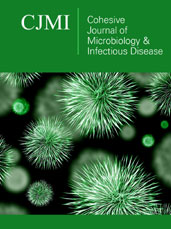- Submissions

Abstract
Cohesive Journal of Microbiology & Infectious Disease
Comparative Molecular Evolution of the Most Dominant and Virulent Recombinant Sars-CoV-2 Variant XE and its Parent Lineage Viruses BD.1 and BA. 2.30
-
Open or CloseMeliscan Arlı1 and Efe Sezgin1,2*
1Department of Biotechnology, Izmir Institute of Technology, Turkey
2Department of Food Engineering, Izmir Institute of Technology, Turkey
*Corresponding author: Efe Sezgin, Department of Food Engineering, Izmir Institute of Technology, Turkey
Submission: May 09, 2025;Published: October 09, 2025

ISSN: 2578-0190 Volume7 Issue5
Abstract
Sars-CoV-2 is a globally circulating virus chronically infecting tens of millions of people every year. In addition to individual mutations, with the advance of the Omicron variant, novel recombinant viruses are emerging. Similar to the effect of mutations on the infectivity and disease dynamics, recombination has the potential to create dangerous viruses. Despite many studies on the mutation-driven variants of Sars- CoV-2, the effect of recombination on the molecular evolution of the viruses is not known. We aimed to compare the molecular evolution of the most dominant and virulent recombinant Sars-CoV-2 variant XE and its parent lineage viruses BD.1 and BA.2.30 using population genetics and phylogenetic methods. High coverage full genome sequences of XE, BD.1 and BA.2.30 viruses were obtained from the Global Initiative on Sharing All Influenza Data (GISAID) web portal. Sequence alignments and phylogenetic analyses were performed by Multiple Alignment using Fast Fourier Transform (MAFFT) and Molecular Evolutionary Genetic Analysis (MEGA), respectively. Annotation was performed using whole genome of the Wuhan type Sars-CoV-2 virus. Population genetic tests included nucleotide diversity, diversification, selection and demographic change tests. Effect of amino acid changes on protein structure and functionality was investigated. Results suggest that recombinant XE variant emerged as a recombination between BD.1 and BA.2.30 sequences most probably by late 2021/early 2022 in Europe and disappeared by the end of 2022. XE genomes had different molecular evolutionary dynamics compared to its parental lineages. The molecular evolution of XE sequences were driven by high number of rare/singleton non-synonymous changes acquired after the recombination event, most of which lead to non-conservative amino acid changes that were eliminated from population level circulation rather quickly. Effective neutralization by host immune system and lack of adaptive mutations that could have conferred increased transmissibility and immune evasion to XE might have led to the eradication of XE.
Keywords: Sars-CoV-2; Recombination; XE variant; Molecular evolution; Selection
 a Creative Commons Attribution 4.0 International License. Based on a work at www.crimsonpublishers.com.
Best viewed in
a Creative Commons Attribution 4.0 International License. Based on a work at www.crimsonpublishers.com.
Best viewed in 







.jpg)






























 Editorial Board Registrations
Editorial Board Registrations Submit your Article
Submit your Article Refer a Friend
Refer a Friend Advertise With Us
Advertise With Us
.jpg)






.jpg)














.bmp)
.jpg)
.png)
.jpg)










.jpg)






.png)

.png)



.png)






